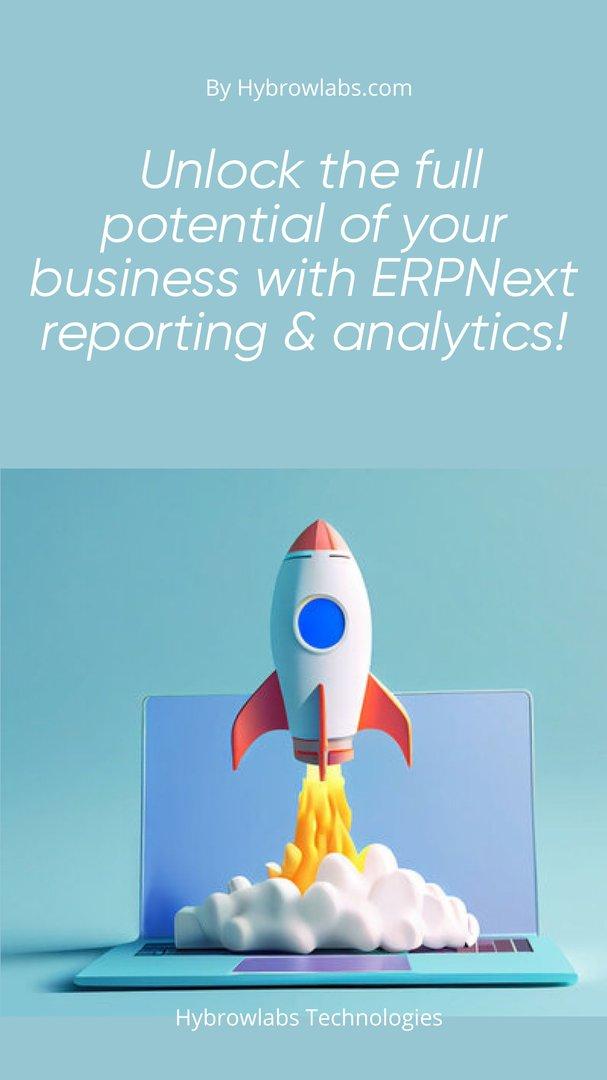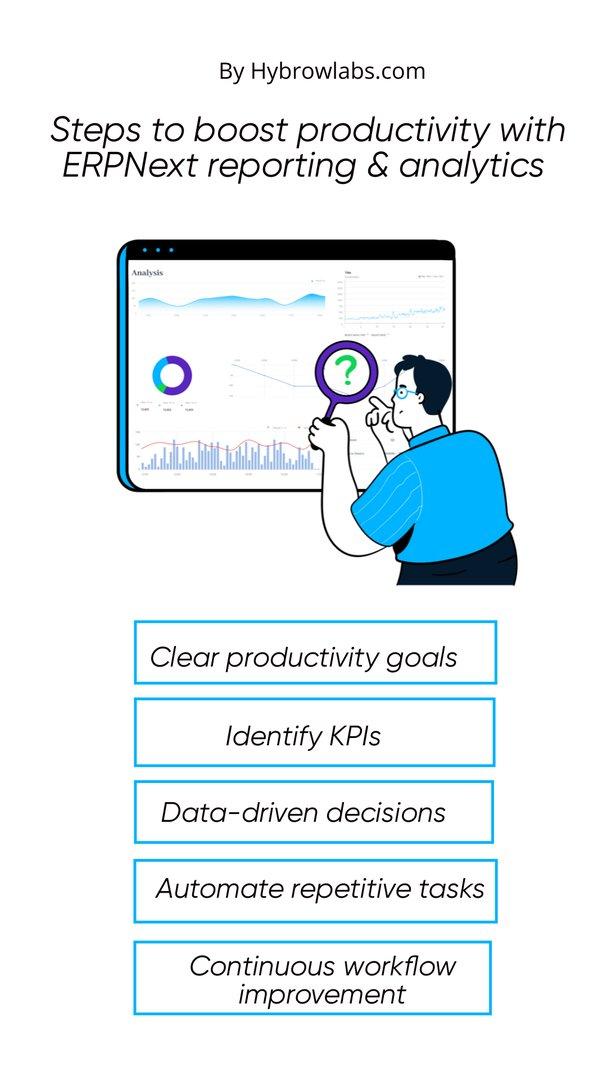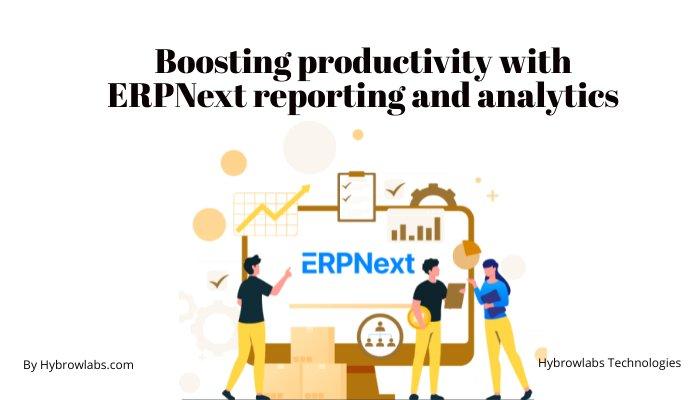
Are you struggling to overcome operational inefficiencies, data silos & a lack of visibility into your business processes? If so, you're not alone. Many businesses today face similar challenges that can hinder their productivity & growth. But what if I told you there's a solution that can help you overcome these obstacles & boost your productivity? Enter ERPNext reporting & analytics. With its real-time data visibility, effective decision-making capabilities & streamlined workflows, ERPNext reporting & analytics can help you take your business to new heights. So, are you ready to discover how ERPNext reporting & analytics can transform your business? Let's dive in and explore how ERPNext reporting & analytics can help you unlock the full potential of your business!
ERPNext reporting & analytics:

ERPNext reporting & analytics refer to the reporting & analytical capabilities within ERPNext that allow businesses to extract insights & make data-driven decisions. With ERPNext reporting & analytics, businesses can create custom reports, dashboards & charts to visualize & analyze their data in real-time. These tools help businesses to understand their operations better, identify trends & make informed decisions to improve productivity & drive growth.
Some important tools of ERPNext reporting and analytics to improve productivity are:
- Custom Reports: ERPNext allows users to create custom reports with filters, groups & calculations as per their specific requirements.
- Dashboards: Dashboards provide a visual representation of important business metrics & KPIs, making it easier to monitor and analyze data.
- Kanban Board: Kanban Board is a project management tool that helps visualize workflows & track progress, improving team collaboration and productivity.
- Pivot Tables: Pivot Tables allow users to summarize & analyze large amounts of data, making it easier to identify trends & patterns.
- Drill-down reports: Drill-down reports provide a detailed view of specific data points, allowing users to analyze & investigate data at a granular level.
- Alerts and Notifications: ERPNext allows users to set up alerts & notifications for important events or milestones, helping them stay on top of their tasks & deadlines.
- Integration with BI tools: ERPNext can integrate with Business Intelligence (BI) tools like Power BI, Tableau & others, providing advanced analytics capabilities & insights into business performance.
The Importance of Productivity in Business:
Productivity is a critical component of a successful business. It is the measure of how efficiently resources are utilized to produce goods or services. Productivity directly impacts a company's profitability, competitiveness & ability to grow. Here are some reasons why productivity is important in business:
- Increased efficiency: Productivity allows businesses to achieve more with fewer resources, reducing costs & improving efficiency.
- Improved quality: Businesses can produce higher quality products or services by optimizing workflows and processes: Improving customer satisfaction.
- Competitive advantage: High productivity enables businesses to be more competitive, allowing them to produce goods or services at lower costs & more efficiently than their competitors.
- Employee satisfaction: When employees feel that they are contributing to the business's success, they are more satisfied & engaged in their work.
The Importance of ERPNext Reporting and Analytics in Boosting Productivity:

1. Real-time data visibility:
ERPNext reporting & analytics provide businesses with real-time visibility into their operations. This allows businesses to make informed decisions quickly & respond promptly to changing circumstances, reducing delays & improving productivity. Real-time data visibility also enables businesses to identify trends and patterns, helping them to optimize their workflows & processes to achieve greater efficiency.
2. Effective decision-making:
ERPNext reporting and analytics provide businesses with the insights they need to make data-driven decisions. This allows businesses to identify areas for improvement & take action to optimize their processes & workflows. By using data to inform decisions, businesses can reduce the risk of making poor choices that could negatively impact productivity.
3. Processes and workflows:
ERPNext reporting and analytics provide businesses with the tools they need to streamline their processes & workflows. By identifying inefficiencies & bottlenecks, businesses can optimize their workflows to reduce waste & increase efficiency. This can result in faster turnaround times, improved quality & increased productivity.
4. Communication and collaboration:
ERPNext reporting & analytics can enhance communication & collaboration by providing teams with a shared understanding of business operations. This allows teams to work together more effectively, reducing delays & improving productivity. By providing a centralized source of information, ERPNext reporting & analytics can also reduce the risk of miscommunication & errors, improving productivity outcomes.
5. Resource allocation and utilization:
ERPNext reporting & analytics can help businesses to optimize their resource allocation & utilization. By analyzing data on resource utilization, businesses can identify areas where they can reduce waste or improve efficiency. This can result in cost savings & increased productivity.
Step-by-Step Processes: Boosting Productivity with ERPNext Reporting & Analytics

To boost productivity with ERPNext reporting and analytics, businesses can follow these steps:
1. Set clear productivity goals:
The first step in boosting productivity with ERPNext reporting and analytics is to set clear productivity goals. This involves identifying specific areas where productivity can be improved, such as reducing cycle times, improving quality, or increasing output. Clear productivity goals provide businesses with a framework for measuring their success & identifying areas for improvement.
2. Identify key performance indicators (KPIs):
Once productivity goals are set, businesses should identify the key performance indicators (KPIs) that will be used to measure progress toward these goals. KPIs should be specific, measurable & relevant to the productivity goals. Examples of KPIs include cycle time, output, quality & resource utilization.
3. Monitor and analyze data regularly:
To track progress towards productivity goals and KPIs, businesses should monitor & analyze data regularly using ERPNext reporting & analytics tools. Regular monitoring enables businesses to identify issues or inefficiencies quickly & take corrective action.
4. Use data insights to make informed decisions:
ERPNext reporting & analytics provide businesses with valuable insights into their operations, which can be used to make informed decisions. By using data to inform decisions, businesses can identify areas for improvement and take action to optimize their processes and workflows.
5. Automate repetitive tasks and processes:
ERPNext reporting and analytics can help businesses automate repetitive tasks & processes, freeing up time for more productive activities. By automating routine tasks, businesses can reduce errors, improve efficiency, & increase productivity.
6. Collaborate and communicate effectively:
ERPNext reporting & analytics can also enhance communication & collaboration by providing teams with a shared understanding of business operations. Effective collaboration & communication can reduce delays & improve productivity outcomes.
7. Continuously improve and optimize workflows:
Finally, businesses should continuously evaluate & optimize their workflows to achieve greater efficiency & productivity. ERPNext reporting & analytics can provide valuable insights into areas where improvements can be made, enabling businesses to take corrective action & drive growth.
How can businesses optimize their use of ERPNext reporting and analytics for maximum efficiency?
To make the most of ERPNext reporting and analytics in boosting productivity, it is essential to follow best practices. Here are some best practices for using ERPNext reporting and analytics:
1. Ensure data accuracy and completeness:
Data accuracy & completeness are crucial for making informed decisions. Therefore, it is important to ensure that the data entered into ERPNext is accurate & complete. This can be achieved by implementing data validation rules and conducting regular data audits.
2. Train employees on ERPNext reporting and analytics:
Proper training is essential to ensure that employees can effectively use ERPNext reporting & analytics. Training should be provided to all employees who will be using the system, including managers & executives.
3. Leverage custom reports and dashboards:
Custom reports & dashboards can provide a more comprehensive view of business operations & help identify areas for improvement. By leveraging these tools, businesses can gain deeper insights into their operations & make more informed decisions.
4. Keep reports and analytics up-to-date:
It is important to ensure that reports & analytics are up-to-date & reflect the most current data. Outdated data can lead to inaccurate insights & decisions.
5. Continuously evaluate and optimize ERPNext reporting and analytics:
Businesses should continuously evaluate their ERPNext reporting & analytics processes and make improvements as needed. This includes identifying areas for optimization, such as streamlining workflows or improving data entry processes & implementing changes to improve productivity.
Conclusion-

However, it's not just about having the tool, but it's about using it effectively. By following best practices such as ensuring data accuracy & completeness, training employees, leveraging custom reports & dashboards, keeping reports & analytics up-to-date, and continuously evaluating & optimizing, businesses can maximize the benefits of ERPNext reporting and analytics.
At Hybrowlbs Technologies, we understand the importance of boosting productivity in today's competitive business landscape. Our team of experts can help you implement & optimize ERPNext reporting & analytics to achieve your productivity goals. With our years of experience in providing technology solutions to businesses across different industries, we have the knowledge & expertise to make sure that you get the most out of ERPNext reporting & analytics.
So, if you're looking to take your productivity to the next level, contact us at Hybrowlbs Technologies today and let us help you leverage the power of ERPNext reporting and analytics.
FAQ-
1. What is ERPNext reporting and analytics?
ERPNext reporting and analytics is a feature that provides real-time data visibility and enables effective decision-making to streamline business processes.
2. How can ERPNext reporting and analytics boost productivity?
By providing real-time data visibility, enabling effective decision-making, streamlining processes and workflows, enhancing communication and collaboration, and improving resource allocation and utilization.
3. What are some causes of low productivity in businesses?
Inefficient processes, lack of data visibility, ineffective decision-making, poor communication and collaboration, and inadequate resources and training.
4. What are some best practices for using ERPNext reporting and analytics to boost productivity?
Ensuring data accuracy and completeness, training employees on ERPNext reporting and analytics, leveraging custom reports and dashboards, keeping reports and analytics up-to-date, and continuously evaluating and optimizing ERPNext reporting and analytics.
5. What types of reports and analytics are available with ERPNext?
Sales reports and analytics, inventory reports and analytics, purchasing reports and analytics, financial reports and analytics, and many more.






a3dc85.jpg)

.jpg)
fd8f11.png)

.jpg)
.jpg)